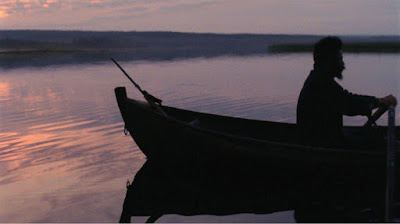Reflections from a Young Movie-Goer
Less
a documentary and more a visual essay, A
Spell to Ward Off the Darkness (2013) is
a collaboration between Ben Russell and Ben Rivers. It follows
musician and artist Robert Aiki Aubrey Lowe through three separate
locations; a commune in Estonia, a forest in Finland and a black
metal gig in Norway. This is perhaps all there is to say on the plot.
All three segments have their own distinct style of film-making. The
commune is observational, capturing conversations both inane and
philosophical (and often both). For instance, there is a discussion
following an orgy in a sauna about whose finger was in whose rectal
cavity, and later one woman explains with a child-like innocence the
spiritually unifying force of Trance music. The Forest has a
meditative, poetic quality to it where the shots cease to resemble
any sort of a narrative and sometimes linger for minutes. The black
metal performance, in contrast, is claustrophobic and raw. Yet,
filmed in only one take that rotates slowly around the band, there's
something hypnotic about it that gives the film's very final moments
of quiet an immense sense of catharsis.
While
all three "spells" feel completely different, not just
physically but emotionally, they all have a meditative, isolating and
intuitive quality to match their natural settings. More than
anything, one is struck by a sense of anarchic alchemy, where each
shot feels caught rather than contrived, unique and particular to
that moment. The exchanges between commune-dwellers. The incredibly
long take of Robert rowing out into a lake, watching a log cabin
burn. The unflinching endurance of the last segment. There is a
rawness and honesty in this technique, which similarly evokes this
lurking darkness within and without. Place and person form a kind of
duality, at times part of one another, and both permeated by the
darkness that accompanies a brooding loneliness. And each mortal
moment evokes a sense of temporality and eternity, one is left to
answer how each "spell" brings value to an otherwise
meaningless life.
At
first one could mistake it for a music video from some obscure,
hipstery post-metal band. The pretensions of those earlier
conversations, the aestheticism of the forest and the brutality of
the black metal performance are easy to pass off as style over
substance. But if one can get past those initial irritants, there's
a more profound, resonant purpose to their inclusion that lurks just beneath the surface.

No comments:
Post a Comment